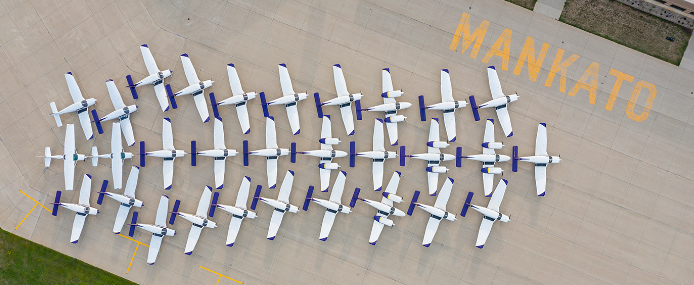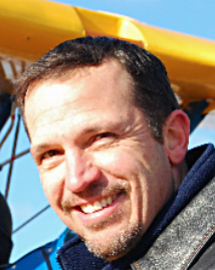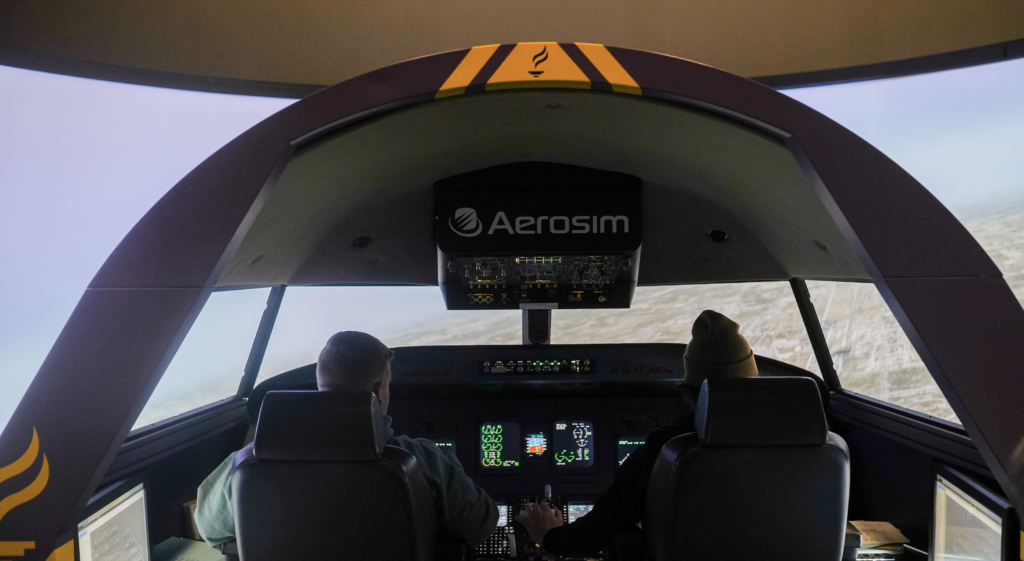Drone Flight Training, Aerobatics and Online Master’s Program on the Horizon

The demand for highly skilled commercial pilots continues to soar. At Minnesota State Mankato, the nationally-accredited aviation program has risen to the challenge, offering comprehensive training, a dedicated team of instructors, and partnerships with leading airlines.
In keeping up with the industry, unmanned drone flight instruction, expanded team jetliner simulation training, and aerobatics training are just some of the new and expanding opportunities for the 600 students seeking careers in aviation at Minnesota’s only four-year aviation program.
‘I’ve never seen anything like it. Demand is so high that if you have all your pilot ratings and you have your hours, I’d say you’re pretty much guaranteed an interview.’
JEFF PETERSON
Aviation Department Chair Jeff Peterson, retired military and commercial pilot and associate professor of aviation, has witnessed the evolution of the University’s aviation program over the past decade.
“When I started with the program 10 years ago, there were just three faculty members. Now, we have nine instructors plus adjuncts,” Peterson explained. This expansion is a testament to the increasing demand for pilots in an expanding industry where pilot numbers were decimated by the effects of 9/11 and Covid.
“I’ve never seen anything like it,” he said. “Demand is so high that if you have all your pilot ratings and you have your hours, I’d say you’re pretty much guaranteed an interview.”
COOPERATE AND GRADUATE
‘Aviation is one of those programs that you really need to study with others. I call it cooperate and graduate. If you’re a loner and you’re trying to go it alone, it’s going to be very, very difficult.’
The Minnesota State Mankato aviation program boasts a vibrant community of close-knit students reaching for the sky.
“Aviation is one of those programs that you really need to study with others. I call it cooperate and graduate,” Peterson said. “If you’re a loner and you’re trying to go it alone, it’s going to be very, very difficult.”
The program fosters a strong common bond through learning communities, where students live together, take classes together, and form lasting connections.
Peterson also notes that in a career historically dominated by men, an increasing number of women are entering the aviation profession.
“Last semester, 18 percent were women,” Peterson said about the University’s program. “It’s still lower than it needs to be but I’ve seen more and more coming into the program.”
This summer, the Purple Tails, four female pilots with the University’s aviation program, are among 19 all-women teams competing in the 46th annual Air Race Classic. The four-day race June 20-23 covers 2,500 miles from Grand Forks, N.D., to Homestead, Fla.
RIGOROUS PREPARATION
The program’s primary focus is to equip students with the necessary certificates and ratings to become professional pilots. Some students may enter the program with prior flight training, however, the program prefers students with no earlier experience to ensure the development of strong foundational skills.
While flying skills are important, Peterson emphasizes the significance of strong study habits among successful aviation students. The program demands a deep understanding of critical subjects, such as weather patterns, airspace regulations, and aerodynamics.
For future aviators, ground schools are conducted on campus, while flight training takes place at the Mankato airport in collaboration with North Star Aviation, the program’s training partner. Aviation students must log 300 hours of flight time flying two primary airplanes: the single-engine Piper Archer and the twin-engine Piper Seminole.
Moreover, the program’s comprehensive instruction extends beyond the fundamentals with such instruction as crew training in a jet airliner simulation. Owning a CRJ700 simulator with plans to add another in the coming year, this unique training experience provides students with valuable crew experience on a typical jet airplane and it prepares them for airline training.
Student aviators completing the four-year program graduate with all the required ratings or certificates from Private Pilot through Instructor, Peterson said. This includes single-engine, instrument and multi-engine ratings.
About 90 percent of students in the program want to become airline pilots. The first challenge after graduation is gaining flight time toward an Airline Transport Pilot certificate. Normally, this requires 1500 hours of flight time, however, students earning an aviation degree from an accredited higher education program such as Minnesota State Mankato benefit from the FAA’s Restricted ATP which reduces the flight hour requirement from 1500 to 1000.
‘How many places can you finish your degree and start getting paid as a professional pilot?‘
To reach that 1000-hour threshold, graduates find employment as instructors at North Star Aviation, where they continue to accumulate flight hours and gain invaluable experience.
“We hope they stay here and teach and most of them do. That’s how they build their flight time,” Peterson explained. “How many places can you finish your degree and start getting paid as a professional pilot?”
Peterson encourages students to explore other career paths within aviation, such as crop dusting, firefighting, corporate piloting, or military aviation. He believes diverse opportunities exist within the industry, and students should consider all options.
Students in the aviation program can also pursue degrees in aviation management offering careers in airport management, aviation safety and security, airline operations and aviation consulting.
WIN-WIN PARTNERSHIP
The aviation program’s continued growth and success can be attributed, in part, to its partnerships with Delta Airlines and Sun Country Airlines.
Peterson said Delta’s Propel program interviews students during their commercial pilot certification, offering conditional employment. Graduates are expected to complete their degrees, acquire all necessary ratings, work as instructor pilots at North Star Aviation, and then progress to Endeavor Airlines. After flying for three years with Endeavor, they have the opportunity to transition to Delta Airlines.
DRONES, AEROBATICS AND ONLINE MASTER’S PROGRAM
‘We’ve always known that we need to have a drone program. That sector of the industry is exploding and the future of aerial drones is very bright.’
To advance the program and make industry recommendations, the aviation program maintains an industry advisory board that meets each semester and includes airline pilots, corporate pilots, and representatives from the Federal Aviation Administration and the Metropolitan Airports Commission.
“They advise us. We share curriculum ideas and they give us feedback to make sure we are current with what we are teaching our students,” Peterson said.
Instructors also attend annual conferences including the Watts World Airline Training Symposium which shares trends in flight training.
New this fall is a new, four-year pathway in Unmanned Aircraft Systems which includes drone flight training.
‘’We’ve always known that we need to have a drone program,” Peterson said. “That sector of the industry is exploding and the future of aerial drones is very bright.”

Among faculty for the UAS program is Jim Dunn, the University’s aviation program director, a former Air Force drone pilot and coordinator.
Also coming this fall will be the addition of courses in aviation aerobatics. Peterson said aviation students can learn basic aerobatic skills by enrolling in Confidence Maneuver Training. During the half-semester ground school, students will take three flights in an aerobatic airplane purchased earlier this year by North Star Aviation.
“Students get to go up in an aerobatic airplane and learn how to do aerobatics, specialized stall spins and upset recovery prevention-type training,” Peterson said. “It’s a confidence builder, thus the name of the lab: ‘Confidence Maneuver Training.”
Targeted for Fall 2024, the aviation program will expand with its first master’s program in Aviation Safety.
“It will be 100 percent online so it will be a chance for people nationwide, worldwide, to join us,” Peterson said.
FOLLOW YOUR PASSION
‘You have to love aviation. If you just want a job that makes a lot of money, that’s a red flag to me. You have to have it in your DNA to want to fly.’
For students serious about a future in aviation, Peterson offers two avenues of advice: One, follow your passion and, two, if you snooze you lose.
While careers in aviation can pay well–an airline captain with five years’ experience can make upward of $266,000–Peterson said passion must be the driving force.
“You have to love aviation. If you just want a job that makes a lot of money, that’s a red flag to me. You have to have it in your DNA to want to fly,” Peterson said.
Peterson also advises getting an early start in pursuing that passion because demand for training tomorrow’s commercial pilots is constantly growing.
“Don’t delay your decision. You need to get into a program and if you want to fly, you need to get into ground school. There’s only so many of those initial ground school classes in the fall and they fill up. So if you’re indecisive, you’ll lose out,” Peterson said.
Still, the program at Minnesota State Mankato offers an enviable combination of size, community and excellent flight equipment for training tomorrow’s leaders in aviation.
“The training is outstanding. You’re flying new airplanes and there’s all those opportunities,” Peterson said. “So yeah, it’s a great time to get into this. It really is.”
WATCH AN APRIL 2023 KEYC NEWS NOW REPORT on the aviation program’s response to the nationwide pilot shortage.
Minnesota State University, Mankato’s Aviation Program is Minnesota’s only four-year, accredited aviation program. More than 90 percent of Aviation graduates report they are working in the field, with many flying as aircrew for domestic and international carriers. Visit the Minnesota State Mankato Aviation website to learn more about the program and career options as well as schedule a visit or apply online.


